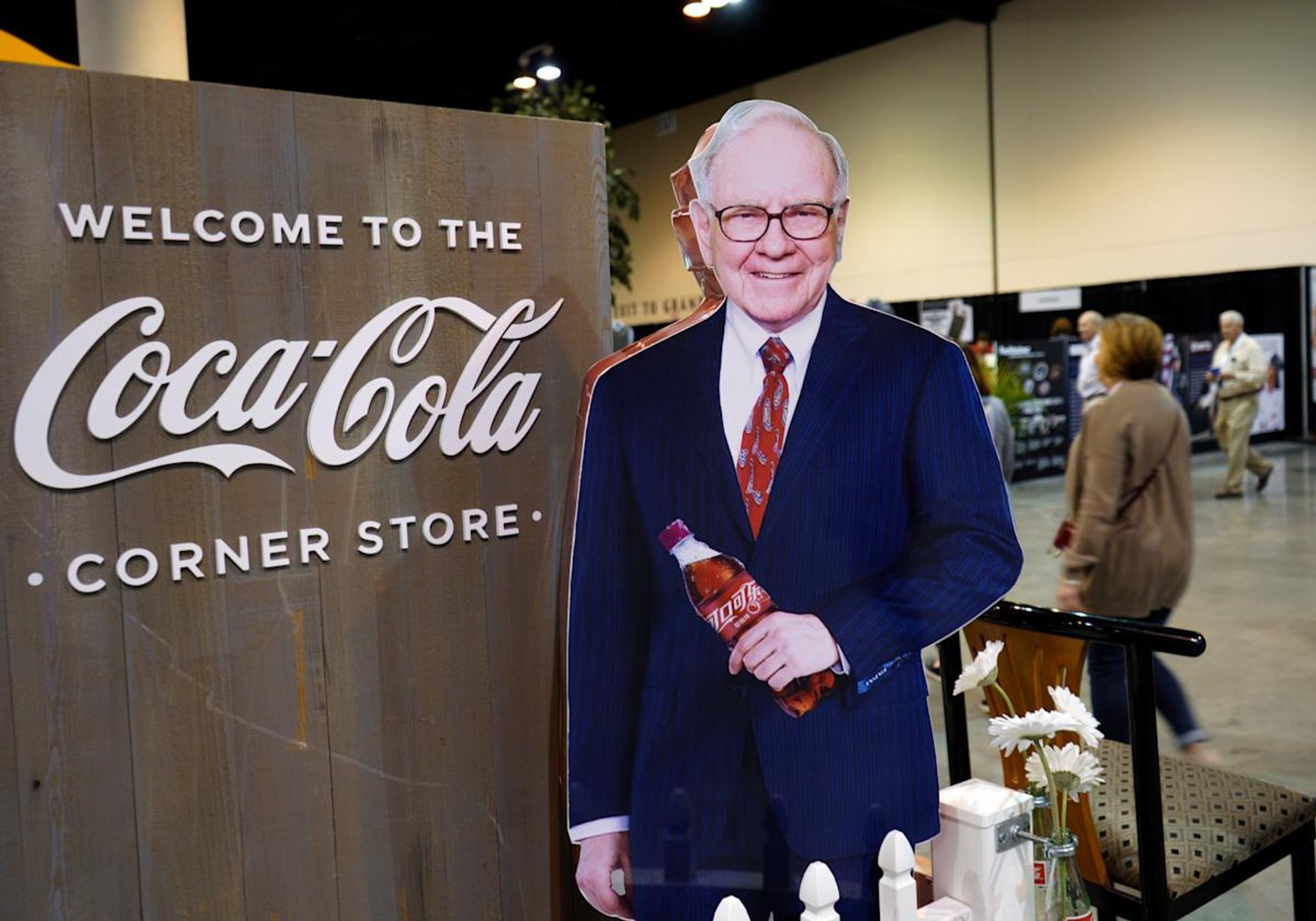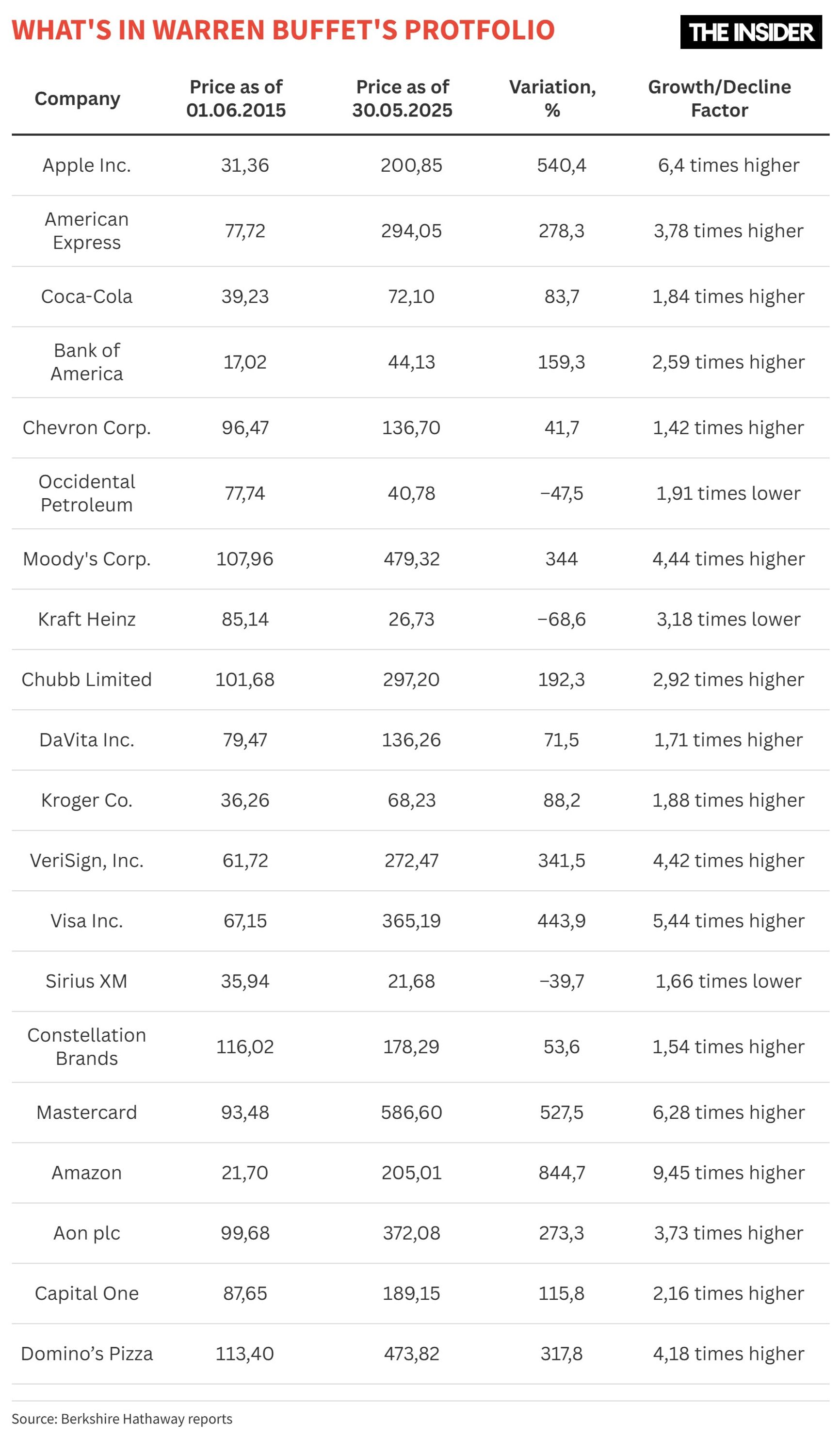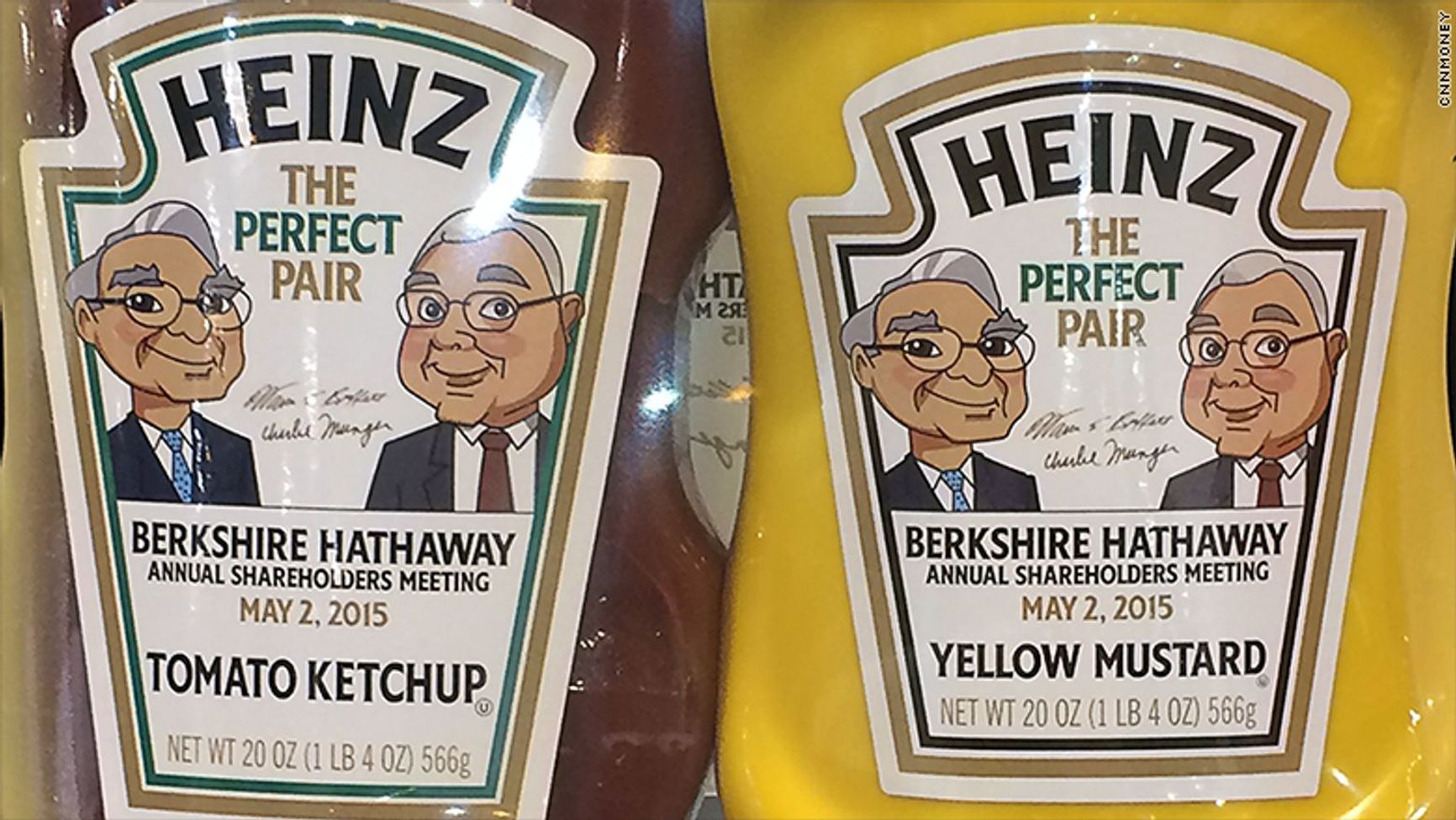

American billionaire Warren Buffett, one of the five richest people on the planet, has announced his resignation as CEO of Berkshire Hathaway, the investment firm he led for 60 years. He leaves behind a company with an unprecedented $348 billion in cash, but the firm’s shares are already beginning to lose their “Buffett premium,” its fate still far from certain. Over the course of its lifetime, Berkshire’s stock has outperformed the market by more than a hundredfold, but that alone says little about Buffett’s skill as an investor, since the stocks managed by Berkshire have become increasingly complex. According to calculations by The Insider, Buffett can generally be called a successful investor: the key stocks in his portfolio have slightly — though not dramatically — outpaced the market overall. Still, investors who believed in tech companies early on — unlike Buffett — have been significantly more successful.
Content
Why Coca-Cola became a symbol of Buffett’s investment strategy
Did Buffett really beat the market?
The results of the last ten years
What Buffett missed
The 94-year-old “Oracle of Omaha,” whose fortune is estimated by Forbes to be $154 billion, often tells those hoping to replicate his success: “If you’re not willing to own a stock for ten years, don’t even think about owning it for ten minutes.” In other words, Buffett advocates patience and well-considered decisions. His number one rule is: “Never lose money.” That is, it's better to invest in a reputable company that delivers steady, modest returns than to bet on a flashy “unicorn” promising to pull riches from thin air.
Buffett began learning these principles at the age of six, when he bought a pack of Coca-Cola cans for 25 cents and sold it for 30. Fittingly, that very soda brand would later become one of the cornerstone assets in his portfolio.
Why Coca-Cola became a symbol of Buffett’s investment strategy
Buffett closely followed the company’s success and first bought its shares in 1988, shortly after the infamous “Black Monday” — the stock market crash of October 1987. This move, incidentally, reflects another one of his principles: buy during a crisis, when others are rushing to offload assets at a discount, thinking they’re saving their money. Indeed, whereas shortly before the crash a Coca-Cola share (adjusted for all subsequent stock splits) cost around $3, Buffett likely managed to buy many at $2.50. By the end of 1989, he had acquired 23.35 million shares, according to the U.S. investment site The Motley Fool.

Despite his childhood success reselling Coca-Cola, Buffett long preferred drinking PepsiCo products — and likely surprised those closest to him when he not only switched to a rival drink, but also poured enormous sums into the company (after years of focusing on media and industrial investments).
In his 1988 letter to shareholders, Buffett outlined another key principle, this time in reference to Coca-Cola: “We expect to hold these securities for a long time. In fact, when we own portions of outstanding businesses with outstanding management, our favorite holding period is forever.” Decades later, he explained that the company needed only to raise the price of a serving by one cent in order to earn an additional $20 million per day.
It is believed that since the initial purchase, Buffet’s company has never sold those shares — it only bought more. Today, it holds 400 million shares worth nearly $28.7 billion. That’s 11% of Berkshire Hathaway’s entire portfolio by value ($258.7 billion) and its third-largest holding after Apple and American Express.
Although the exact date of the first purchase is unknown, using the price of $2.44 on June 1, 1988, and $72.10 on May 30, 2025 — a span of 37 years — at least part of the investment has grown by a factor of 28.5 — a return of 2,754%. And that’s not including dividends: from 1995 to 2019 alone, Berkshire earned about $7 billion in payouts (today, each share brings in just over two dollars annually).
Buffett’s personal shares, however, will not go to Berkshire. After his death, the vast majority will be donated to charity. In other words, when he spoke of “forever,” he meant it in every sense.
Did Buffett really beat the market?
According to the latest annual report from Berkshire Hathaway, between the time Buffett took control in 1965 and the end of 2024, the company’s own shares grew by 5,502,284%. That’s more than a 55,000-fold increase. In practical terms, an investor who put $1 into Berkshire 60 years ago would have $55,000 in 2025. For comparison, the S&P index — which reflects the performance of the 500 largest U.S. companies — rose by a comparatively modest 39,054% over the same period, meaning each invested dollar would have yielded $390. In other words, Buffett’s company outpaced the market by a factor of 141. If we look at average annual growth, the numbers are more modest but still impressive: Berkshire’s shares gained 19.9% per year on average, compared to 10.4% for the S&P. Today, a single Berkshire Class A share trades at a staggering $736,000.
But these figures say nothing about Buffett’s actual stock-picking instincts — they reflect the rise of his company, not the performance of the stocks it manages. Buffett became a billionaire largely by convincing others that he knows how to manage money effectively. Whether that belief is justified, however, is better judged by looking at the performance of Berkshire’s portfolio — something much harder to calculate.
Buffett’s conservative strategy means he tends to miss out on the massive gains characteristic of early-stage market entrants, as happened with major tech startups. For example, Buffett’s beloved Coca-Cola shares rose 29-fold between June 1, 1988, and May 30, 2025. But over the same period, Microsoft shares went from 47 cents to $460.36 — a nearly 1,000-fold increase. Buffett hasn't avoided Big Tech entirely, as Apple now holds a prominent place in his portfolio. But he didn’t buy Apple shares until 2016. Meanwhile, the S&P 500 index has grown 22-fold since June 1, 1988 (from 273 to 5,912 points). So while Buffett didn’t ride the tech boom to its peak, on average he still managed to slightly outperform the broader market.
The same pattern holds for one of Buffett’s oldest holdings: American Express. Starting from 1972 — the earliest year with reliable post-split pricing data — the credit card company’s stock rose from $4.10 to $294.05, a 71.7-fold increase. During the same time, the S&P 500 grew by a factor of 55. Buffett outpaced the market, though someone who invested in Apple or Microsoft early on would have earned more in ten years than a Buffett-style portfolio returned in fifty.
A third example: in August 2011, Berkshire struck a deal with Bank of America, acquiring the right to buy shares at $7.14 apiece. Today, those shares are worth $45.09 — a sixfold increase. That beats the market (the S&P 500 has grown fivefold since August 1, 2011). But had Buffett bought Facebook shares at their May 2012 IPO price of $29.60, he’d now be sitting on a 24-fold gain — they currently trade at $702.40.
The results of the last ten years
Berkshire currently holds shares in 36 companies. For convenience, we’ll list 20 of them — those that account for the largest share of the holding’s investments — and look at how their value has changed over the past ten years. (It’s worth noting that some of these holdings, like Coca-Cola and American Express, have been in the company’s portfolio for decades, while Apple was first acquired just under nine years ago.)

So what counts as explosive growth — and what doesn’t? In general, an investment is considered successful if it delivers an average annual return of around 15–25% — roughly in line with the annual growth rate of the S&P 500 index. Given that we're analyzing a 10-year period, investments yielding a total return of 150–250% over those ten years can be considered effective. As it turns out, Buffett has quite a few of those. But not all. For instance, the growth of companies like Chevron (41.7%), DaVita (71.5%), or Kroger (88.2%) amounts, in essence, to a loss.

If we subtract the accumulated 10-year U.S. consumer price index inflation of 36.11% (as calculated by The Insider based on data from the Bureau of Labor Statistics), we’re looking at very low real profitability. And Buffett's portfolio includes several companies whose shares have declined significantly over this period — meaning that, if one follows Buffett’s own logic, now might actually be a good time to buy them. In addition, there are clearly stocks that Buffett unjustifiably overlooked.
What Buffett missed
Quite a lot, in fact. For example, on June 1, 2015, one share of Tesla cost $17.88, and by May 30, 2025, it had reached $346.46. That’s an increase of 1,838% — or a 19.4-fold return. Buffett’s most successful asset over the same period — Amazon (which he only started buying in 2019) — rose 844%, or 9.5 times.
Tesla rose 1,838%, or 19.4 times, over ten years — twice as much as Buffett’s best-performing asset
In 2024, Elon Musk even replied to a post on social media platform X, saying that Berkshire buying shares in his companies would be an “obvious move.” But as U.S. analysts reviewing Buffett’s portfolio have noted, Tesla doesn’t fit the mold of companies he tends to favor: its price-to-book ratio is among the highest on the market (which can signal overvaluation), and it doesn’t pay dividends. Still, observers acknowledged Tesla was delivering strong profits — a definite plus.
A share of the streaming platform Netflix cost $93.85 on June 1, 2015, and $1,207.23 on May 30, 2025. That’s a nearly 13-fold increase, or 1,186%. And there are even more dramatic examples. Processor developer AMD was trading at $2.40 in June 2015 (like Coca-Cola once did), and a decade later it had reached $110.73 — a 46-fold increase, or 4,514%. Shares of graphics card manufacturer NVIDIA, which cost 50 cents ten years ago, now trade at $135.13. That’s a 270-fold surge, or 26,926%.
Analysts point out that Buffett tends to invest in “evergreen” companies — those whose products are always in demand. These often include food companies, which likely explains his heavy investments in pizza, beer, ketchup, and soda businesses. He also considers financial services and oil to be ever-relevant assets — though judging by Chevron’s performance and the rise of alternative energy, that bet may prove to be a miscalculation.
Buffett, however, tends to steer clear of the tech sector, believing it may not deliver predictable long-term profits. The clear exception is Apple, which holds the top spot in Berkshire’s portfolio — accounting for 26% of the total value of all the stocks in its basket. But Apple was founded in 1976, relatively early on in Buffett’s own career. He had followed it closely for years, and the asset was, in his words, “completely understandable.” By contrast, most of the trendy — or even moderately trendy — tech giants emerged in the 1990s and 2000s, when Buffett was already well into his sixties. Perhaps he simply didn’t trust them in an old-fashioned way (even if tech company SiriusXM, along with Amazon, became notable exceptions.)
The billionaire turns 95 this August. He does not believe in cryptocurrencies — but he also readily admits he doesn’t understand them. You could poke fun at that, but let’s be honest: at this stage, he neither needs the headache nor the knowledge. Not buying Tesla, even when the benefit seemed “obvious” was a pass Buffett could afford in every sense of the word. He’s more than earned his fortune.
At a company event in 2024, he smiled and said, “We only swing at pitches we like.” In other words, in baseball terms, only go for the stocks you truly believe in. And judging by the results, that approach still works.